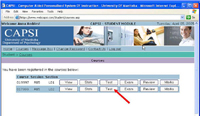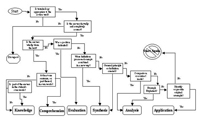|
PUBLICATIONS
Crone-Todd,
D.E., Eyre, H. L., Hutchens, S. A., Jones, J. R., & Pear,
J. J. (2007). The effect of changing grading criteria on student
writing. The Behavior
Analyst Today, 8,
35-42.<
Crone-Todd,
D.E., & Pear, J.J. (2001). Application of Bloom's Taxonomy
to PSI. Behavior Analyst Today, 3, 204-210.
Crone-Todd,
D. E., Pear, J. J., & Read, C. N. (2000). Operational
definitions for higher-order thinking objectives at the post-secondary
level. Academic Exchange Quarterly, 4(3), 99-106.
Kinsner,
W., & Pear, J. J. (1988). Computer-aided personalized
system of instruction for the virtual classroom. Canadian
Journal of Educational Communication, 17, 21-36.
Kinsner, W., & Pear,
J. J. (1990). Dynamic educational system for the virtual campus.
In: U.E. Gattiker (Ed.), Studies in technological innovation
and human resources. Vol. 2: End-user training (pp.
201-228). Berlin: Walter de Gruyter.
Martin, T. L., Pear,
J. J., & Martin, G. L. (2002). Feedback and its effectiveness
in a computer-aided personalized system of instruction course.
Journal of Applied Behavior Analysis, 35, 427-430.
Martin, T.L., Pear, J.J.,
& Martin, G.L. (2002). Analysis of proctor marking accuracy
in a computer-aided personalized system of instruction course.
Journal of Applied Behavior Analysis, 35, 309-312.
Pear,
J. J. (2002). Teaching and researching higher-order thinking
in a virtual environment. In J. A. Chambers (Ed.), Selected
papers from the 13th International Conference on College Teaching
and Learning (pp. 143-150).Jacksonville, FL: Florida Community
College at Jacksonville.
Pear,
J. J. (2003). Enhanced feedback using computer-aided personalized
system of instruction. In W. Buskist, V. Hevern, B. K.Saville,
& T. Zinn (Eds.). Essays from excellence in teaching
(vol. 3, ch. 11). Washington, DC: APA Division 2, Society
for the Teaching of Psychology. (see
the article)
Pear,
J. J., & Crone-Todd, D. E. (1999). Personalized system
of instruction in cyberspace. Journal of Applied Behavior
Analysis, 32, 205-209.
Pear,
J.J., & Crone-Todd, D. E. (2002). A social constructivist
approach to computer-mediated instruction. Computers &
Education, 38, 221-231.
Pear,
J.J., Crone-Todd, D.E., Wirth, K., & Simister, H. (2001).
Assessment of thinking levels in students' answers. Academic
Exchange Quarterly, 5(4), 94-98.
Pear,
J. J., & Kinsner, W. (1988). Computer-aided personalized
system of instruction: An effective and economical method
for short- and long- distance education. Machine-Mediated
Learning, 2, 213-237.
Pear,
J. J., & Martin, T. L. (2004). Making the most of PSI
with computer technology. In D. J. Moran & R. W. Malott,
Evidence-based educational methods (pp. 223-243). San Diego,
California: Elsevier & Academic Press.
Pear,
J. J., & Novak, M. (1996). Computer-aided personalized
system of instruction: A program evaluation. Teaching of
Psychology, 23, 119-123.
Springer,
C. R., & Pear, J.J. (2008). Performance measures in courses
using computer-aided personalized system of instruction. Computers
& Education, 51, 829-835.
|




